High definition surround sound isn’t only a matter of having nice speakers. In the process of creating high quality audio, distortion can weasel its way into a signal at countless junctures. About half of the responsibility of creating high quality sound goes back to the receiver you’re using to send sound signals to speakers.
But in many cases, quality isn’t the issue at all. Instead the issue is capability. When it comes to high quality surround sound, whether or not a receiver is capable of doing what you want isn’t something you can take for granted. And it requires a close look at a receiver and its features to truly understand what you’re getting yourself into.
Onkyo TX-NR686
Onkyo isn’t a household name like Sony, but within the audio industry, they have essentially the same degree of respect. Onkyo has established a reputation for making some of the best sounding home cinema receivers on the market, and for making reliable products that seem to get better with each generation. Granted, major advancements in audio technology tend to occur slowly. As a result, most stereo receivers don’t receive many huge improvements from one generation to the next. But the Onkyo TX-NR686 is different.
From a consumer standpoint, the TX-NR686 is a mid-range receiver with strong specifications on both the audio and video portions of its design. It’s made distinct from previous Onkyo receivers with its native support for both of the latest and greatest formats for surround sound, DTS:X and Dolby Atmos. It’s also THX certified, and uses up-mixers to help boost legacy content to digital 3D surround sound. Even for content that wasn’t specifically designed to be heard with surround sound, you can end up with stunning recreations.
Device Connectivity
Along the back of the device, you’ll find six HDCP 2.2 HDMI inputs, which are suitable for 4K content and other high definition formats. Those ports are also suitable for HLD, Dolby Vision, and HDR10. In the interests of convenient and quick installation of your sound equipment, the various ports are visually broken into two separate zones of operation. Each distinct zones allow you to rig-up and run separate speakers for multiple rooms. You can then do playback of both zones simultaneously, or even use independent audio sources from each zone of operation.
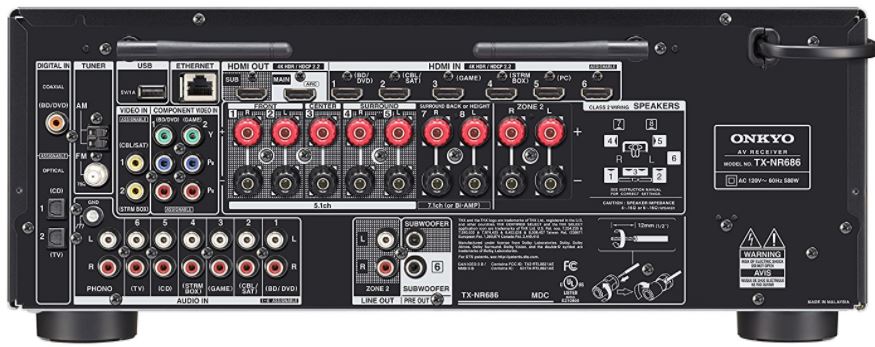
Onkyo includes a fairly inclusive support for music networks, including Amazon Music, Deezer, Spotify, TuneIn, Tidal, and Deezer. Each are easily accessible through the Onkyo Controller. Already it sounds like every base is covered, with a range of wireless and wired connectivity. But the TX-NR686 also supports Bluetooth, AirPlay, Google Chromecast, and a number of other streaming services. Absolutely every connection you could want is present, with the exception of some legacy ports.
Sound Quality
Listening to the TX-NR686, you can immediately tell that audio quality is beyond the range of what you’d expect, likely thanks to an auto-calibration feature. That feature helps you measure the resonance of your room, allowing you a greater degree of fine-tuning the sound to accommodate your unique surroundings. Not all sound settings will sound equally great in any space, so being able to make those kinds of adjustments adds a great deal.
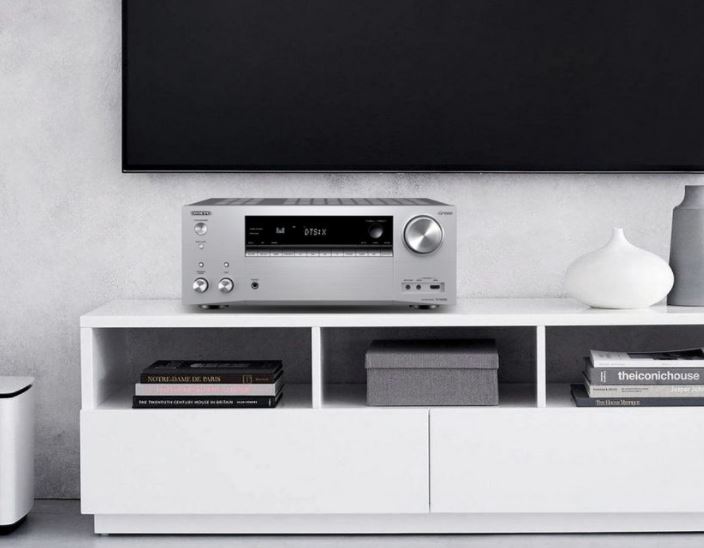
The TX-NR686 runs at 100W, a slight bump over its 95W predecessor. With a 100W load there’s as little as 0.08% electronic distortion. From a hardware perspective, the TX-NR686 compares favorably with low-end audiophile equipment. It may not earn any awards from audiophiles who are snobs about sound quality, but neither would it earn their scorn. The supported 24-bit 192kHz playback is perfect for keeping noise down and clarity up, helping your speakers achieve their fullest potential.
The receiver itself supports 5.2.1 channel sound. You’ve probably heard of 5.1 channel sound, and if you understand what that term means, then the additional decimals in 5.2.1 description will sound rightfully confusing. But confusion is needless because the 2 refers to the supported additional height channels, while the 1 refers to a subwoofer. Those extra height channels are what make Atmos possible. Technically speaking, a totally complete surround sound experience would require four height channels, but expanding beyond two would drastically increase the cost of the receiver.

Surround Sound Support
DTS:X and Dolby Atmos are object-based surround sound formats. For people creating audio content, they provide better control over the placement of various effects within the soundscape. They’re also what’s responsible for the height speakers, sending sound downwards from above. Large movie theatre chains often use one or both formats, helping them to provide the distinct immersive sound quality you’ll find at the cinema.
Unfortunately, Dolby Atmos and DTS:X aren’t yet massively compelling features because they’re relatively new formats. But almost daily, more films supporting one of the two are released. With time, surround sound support may be just as standard as the Blu-ray format. It doesn’t matter if you’re talking about physical formats like VHS tapes, CDs, DVDs, or digital formats like Dolby Atmos, either way adoption takes time.
When you have a Dolby Atmos setup, the TX-NR686 allows you to take called of AccuEQ calibration software. Specifically, you’ll want to look for a feature called AccuReflex, which can phase-match the non-directional and directional sound on an Atmos system. Even though the resulting sound isn’t as accurate as sound that’s been specifically programmed for Dolby Atmos, the imitation is quite passable. Support for DTS:X and Dolby Atmos isn’t only about futureproofing your sound system, you can immediately see improvements in listening to old favorites.
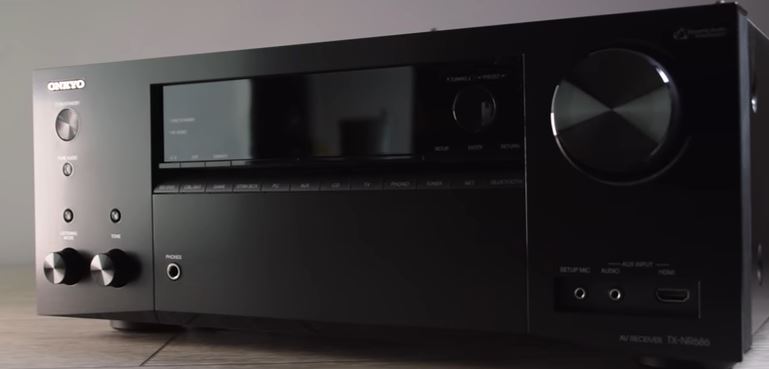
Build & Design
Most AV receivers are intended to sit at the bottom of an entertainment console, neatly resting out of sight and out of mind. Onkyo’s receivers embrace that fate, and don’t make much of an attempt to jazz-up the aesthetic of their design. Even the LEDs used to provide track information are composed of a muted green that could at best be described as unassuming and simple. It looks incredibly generic and non-descript, resembling one of hundreds of similar receivers.
The receiver itself stands just over 17-inches wide, 7-inches tall, and slightly over 12-inches deep. That’s the bulky build you ordinarily see on midrange stereo receivers. On the face of the device, the LCD menu is the same menu system used on Onkyo’s much earlier units. The green and black background may have a familiar feel to those who’ve used Onkyo products in the past, but will seem ancient and minimalistic to everyone else.
If you’re a fan of vinyl, you’ll appreciate the magnetic stage along the backside of the TX-NR686, which allows you to attach a turntable. Onkyo recognizes there’s a huge range among turntable quality, and have consequently decided against including a turntable along with the TX-NR686. That’s probably a smart design decision because if they’d added an ordinary-quality turntable, people who care about vinyl wouldn’t approve of the quality. And if they added a higher quality turntable, the TX-NR686 would’ve seen a price increase that would scare away consumers who didn’t care about vinyl.

Other Considerations
The remote is genuinely terrible. It’s covered with nearly 60 buttons, so using it is more confusing than operating an aircraft. The buttons you’ll use the most, like the volume and menu buttons, are far too small to be convenient. Important buttons are often no larger than less important buttons. Although you can press a button and it will do what you expect, it can take weeks of use to feel truly comfortable using the remote.
If you do open the options, the settings you find are mostly the usual suspects. You can use an equalizer to help fine-tune your sound, even from speaker to speaker. If you’re looking for something quick and dirty, there are three presets you can switch between. Whether you’re trying to get great sound for your movies, or you’re jamming out to some music, you can toggle between your saved presets to get the right sound for any activity.
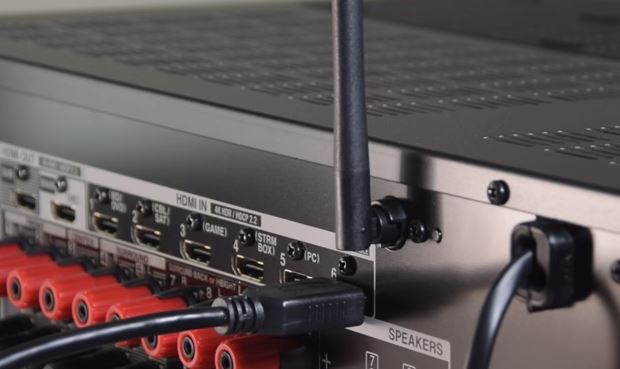
On the video side of things, the 4K pass-through ensures that your sound quality and video quality can match, and it works flawlessly. Supporting 4K content helps ensure this receiver remains relevant now and in years to come, as the popularity of higher resolution content continues to build and spread. Even if you’re not currently using a 4K setup in your home, it’s nice to know your receiver is equipped for it in the future.
Unfortunately, the Bluetooth feature is input only. That means you won’t be able to directly connect to the receiver through Bluetooth headphones, but creating a work-around for that kind of problem usually isn’t difficult. One limitation you can’t easily work-around involves subwoofers. Unpowered subwoofers won’t work because this receiver isn’t equipped to provide power to them, so you’ll need your subwoofers to provide their own power source.
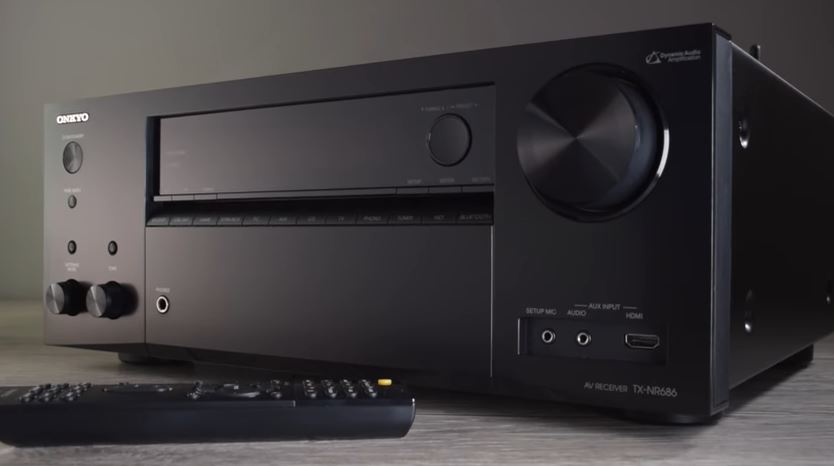
Who Should Choose the Onkyo TX-NR686?
The Onkyo TX-NR686 delivers on the latest and greatest technologies in sound formatting, especially DTS-X and Dolby Atmos. With the addition of wireless services like Wi-Fi, Bluetooth, and AirPlay, you’ll have no problem making quick and easy wireless connections from essentially any device. The hardwired connections are just as easy, and include eight HDMI inputs, a phono input, and two outputs.
If you’re willing to spend hundreds more, then you find a top-shelf receiver that supports four height channels instead of two. And if you’re only interested in creating sound in one space, then you can probably find a smaller receiver with fewer connection options. But for what it does, you’ll have a hard time finding a better 5.2.1 channel receiver at this price range.
For a future-proof sound system that supports both of the latest and greatest surround sound technologies, the TX-NR686 is a great choice. It offers high-tech sound processing that’s ideal for movies and music alike. And for the purposes of providing sound in two large rooms, it’s offers the perfect amount of power and connectivity. It’s a great pick for just about any audio enthusiast on a budget.
Meet Ry, “TechGuru,” a 36-year-old technology enthusiast with a deep passion for tech innovations. With extensive experience, he specializes in gaming hardware and software, and has expertise in gadgets, custom PCs, and audio.
Besides writing about tech and reviewing new products, he enjoys traveling, hiking, and photography. Committed to keeping up with the latest industry trends, he aims to guide readers in making informed tech decisions.

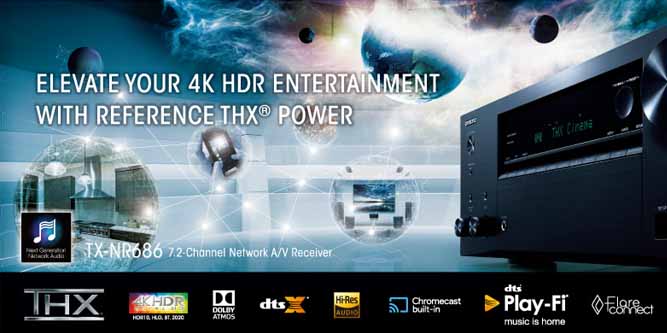

How about harman kardon?
Thanks – nice review!
Hello all I just got this bad boy today and so far I’m very happy with it. I’ve owned many amps denon marantz pioneer yahama Sony and now onkyo to be fair the best amp I’ve had is the yamaha rx-v3079 the thing is a beast but to big for my house. The onkyo does everything I need and everything I want the sound is amazing for the price I’d recommend this amp to anyone wanting good bass and loud thumping movies and music.
@Edwin – Harman Kardon (and I’m a huge fan of HK) has essentially abandoned the home theater AVR market. They refuse to produce ANY AVR at ANY price point that will support Dolby atmos or DTS-X. I even wrote to them, and they essentially confirmed that. As a result, I recently purchased this Onkyo TX-NR686. I love it.
This review is spot-on. It’s certainly not audiophile quality, but for the average home theater nerd like me; it sounds fantastic. And the difference between legacy 5.1 and 5.2.1 atmos processing is truly unbelievable. My room is not big enough for 7.2.1 or better, so this was the perfect solution.
We are trying to connect 2 subwoofers,can anyone help with this we can’t figure it out
its very easy to do. Just connect one sub wire from the sub out 1 to the in of the Sub and then do the same for the other sub from the second sub out from the reciever. and adjust your subs settings and your done.
why 2 subwoofers? at those low frequencies, one is enough
@chris. I see. I like hk but i can not find any latest avr from hk but now im planning to purchase onkyo 686. At present im busy reading reviews for onkyo 686 before im going to buy it i have to make sure that onkyo686 is the best avr…
MR. KEVIN, FROM YOUR AMPLI. ONE SUB OUT RIGHT? JUST BUY A ” Y ” TYPE CABLE INORDER TO HAVE A TWO OUTPUT FOR SUBWOOFER.
Tech Guru. I see you reviewed this (Onkyo TX-NR686) and the Pioneer VSX-LX103 a few days apart from each other and you do recommend both, with you calling the VSX-LX103 a good entry level receiver. Throughout the internet, I see the TX-NR686 is picked often as a top receiver (even the TX-NR676) does, especially for the value price and performance compared to other AV units that have a much higher price. For the VSX-LX103, though, other than a few reviews here and there, I don’t see it listed as “top” receiver in anyone’s list, yet, at some retailers (though they are similarly priced) reps seem to think that the VSX-LX103 y a better performing and better buy than both, the TX-NR676 and the TX-NR-686… what is your take on it? I already own a TX-NR636 and I love it.
Thanks
Actually the 686 has a second plug for a rear sub but is the same channel as the front.
Hi I’m about to purchase a new receiver in this is in my top 3. I’m confused about the turntable aspect of the reviews is this receiver good for turntables or not? Also I have PSB image 5T front speakers should I be looking at a better quality receiver or will this do. Thanks
I have the 686 and just purchased a Polk 10 inch active subwoofer. It has 2 connections a R & L, how does this baby connect to the 686. Cant seem to get the boom I’m looking for.
You use a subwoofer cable……one end in sub on the reciever. The other end goes in L (left) on the subwoofer. If the subwoofer has LFE you will use that.
The “BOOM” is all about settings. Normally, frequency is all up, volume half way up (for a start)
To callibrate your speaker it’s best to use a soundmeter calibrating your speakers and subwoofer.
Going from an older txnr 737 witch is ment to be a lemmon or failure to the 686 was a complete waste of money sound quality is not even close to as good i dont think it has a 4k upscaler like the 737 im now getting the tempreture sensor fixed and then am going to put the 686 in its box and in storage incase my 6 yearold 737 need repair again
I realize this is the 2018 model, but I just purchased it a few days ago. The only thing I am struggling with is trying to figure out how I can use wireless speakers with it in other rooms to have music playing throughout the house. The Onkyo NCP-302 can’t be found anywhere. Looking for a way to add a wireless speaker in each of two rooms for music through the receiver. Any solution other than Sonos?!
Hello I was told by a Best Buy tech that this receiver will not effectively power 5 Acoustic Audio CS-IC83 in Ceiling 8″ speakers and Polk -Psw-10 sub. Do you agree?